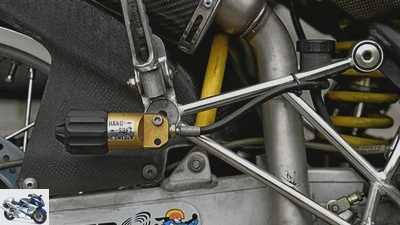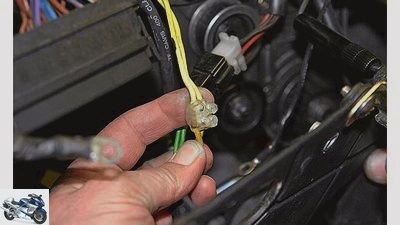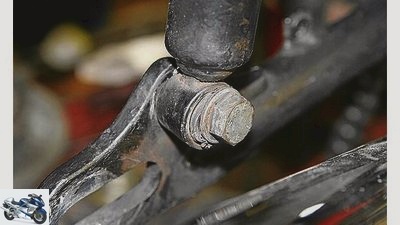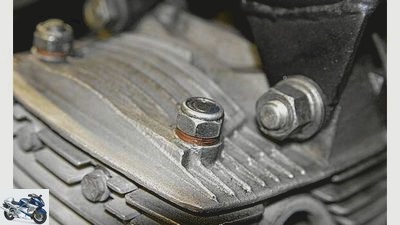Table of contents

Photos: Franz Josef Schermer
counselor
workshop
Workshop guide
Workshop guide – provisional
Recognize botches on the motorcycle
Recognize botches on the motorcycle? … except for a temporary solution. Unless it breaks before that.
Franz Josef Schermer
04/28/2011
Our whole life is made up of little things. Every day, every hour, every minute, the human brain has to process innumerable impressions and produce thoughts, which then become decisions and actions. According to the brain researchers, it should not be just 1001 impressions, but actually around 40,000 – per day! The brain as a decision maker has to be in top shape professionally and socially, otherwise the decision made will go wrong and a negative chain reaction will set in.
It is similar with such a complex machine as the motorcycle: Even a tiny incongruous little thing in the power supply, in the gasoline system, in the lubrication can inhibit the running of the engine and cause it to die. Slightly defective controls can cause the driver to make an incorrect move, which then generates an incorrect signal that provokes incorrect reactions from other road users. A fault in the chassis can lead to the driver falling and – yes, not more at this point, otherwise it will be too negative.
We often have such philosophical thoughts in our editorial office, where the “Motorcycle repair guides” develop. We have already pushed countless machines down the catwalk (vulgo: the lifting platform), new and old, Japanese, German and Italian bikes to examine, disassemble, photograph and ultimately write about. No botch goes undetected. And we want to report on such things at this point: Not to lift the index finger and “Never do that!” to shout, but to show a few things that are apparently irrelevant, but can make a difference between driving and stopping a machine.
Electrics

Schermer
Luster clamp on the motorcycle – that can get really hot.
When the copper worm rages, the exhaust beats quickly become very quiet. Look at the battery connector, is that what? The yellow creeps between the screw head, socket, connection eyelet on the cable and connection on the battery. The transition resistance will soon be so high that the starter will no longer turn when the starter button is pressed and the crankshaft will simply stop. “Fucking car!”, exclaims Franz Matz, and the spring trip is over. The remedy could have been so simple: Remove the connection, clean it with fine emery paper and lubricate it with pole grease. A thick spot in the two-wire, yellow cable that leads from the alternator to the regulator is noticeable; it doesn’t bode well, because the insulating tape wrapped around it has already been deformed by heat. After unwinding, a tension-overloaded luster terminal that is therefore melt-deformed by heat appears. During the next long trip, the cables in the area around the terminal would have started to burn and so would the motorcycle. Either a standard multiple connector or one should be used here “flying fuse” with 40 amps. The turn signal hangs at half past seven, the turn signal switch no longer clicks and can only be opened after “6-out-of-49”-Switch off the principle and the flasher relay is suspended from the contacts on the frame with a cable tie. Note: If you blink in the wrong direction or not at all, you can be rammed into or even run over by your neighbors in traffic. Obviously the stupid driver is to blame, because afterwards it wasn’t anyone who saw the wrong direction indicator (or not at all)
mechanics

Schermer
Worn rubber bushings can lead to expensive consequential damage.
If the clutch jerks when starting up, shifting gears and driving in a convoy and therefore bucks the cart, please do not look for sand in the tank, install new spark plugs or even sell a tuning e-prom: the claws on the clutch disks do not have each other only hammered into the clutch basket, but also thinned by around half. Clutch sloppiness like this is also a result of the gearbox, because they tear at the teeth of the gear wheels and break the chain – they are just not fun. A completely new clutch has to go in there.
A stud bolt on the exhaust bracket has been torn off. Fortunately, you can turn the rest out with pliers. Because there is no new stud bolt available, a size 8 screw is sawn off and a slot is cut in. the “new studs” but cannot be screwed in tightly with it, it will be level “slightly hand-tight” screwed in. This does not last in the long run, because the sealing ring on the exhaust manifold flange compresses and the tension in the screw connection decreases. Therefore, only the professional installation of a new stud helps (yes, I know: according to the standard “Stud screw”). The best thing to do is to repair the thread in the cylinder head with Helicoil, then it will last forever.
The holes on the rear exhaust bracket did not match, so a piece of flat iron was sawn off and two holes drilled in it. That is good in itself and goes in the direction of “permanent temporary solution”, but if the flat material is half too thin and the screw connection is carried out without or with too small washers and spacer sleeves that are too thin, then you can see that the mechanic has no design feeling for a “durable temporary” because such an exhaust bracket will break off soon.
There are some rubber components on every motorcycle: grommets over Bowden cables, dampers and spacer bushes in strut eyes, coolant hoses. Because the plasticizers evaporate from the rubber under the influence of UV rays, rubber becomes porous over time. Wrapping a porous rubber grommet over the throttle cable adjuster on the carburetor with insulating tape is just as messy as accepting an age-related crushed rubber bushing in the lower strut eye.
Incidentally, the weld seam of the steel bushing at the bottom of the shock absorber was torn off as a result of the damage, because the short impacts that acted on the shock absorber for a long time while driving (or suspension) arrived undamped: an old, porous, hard and compressed rubber can hold no longer fulfill the task assigned to him.

Schermer
It is best to replace the aluminum and copper seals every time.
It is no different with an old cooling water hose or one that has been scuffed by a fall: Don’t just wrap insulating tape around it and then forget it, but replace it at the next opportunity, because if the scuffed hose tears, all the coolant is removed within a few seconds and the engine overheats. And if the coolant gets onto the rear wheel, a crash is guaranteed.
Two sealing washers instead of one – that’s not okay either. Aluminum and copper sealing rings should be replaced every time because they are squeezed when the screw connection is tightened for the first time; they adapt to the surface of the components to be sealed. If you don’t have new sealing washers, you can get a used copper sealing washer “to anneal” and so soften it up again: put the heating plate on a high level, heat the copper washer on it thoroughly, remove it with pliers (!) and place it on a clean and smooth steel surface, apply a few targeted and prudent blows with a hammer and then throw it into the water bath.
Sorry, dear readers, we didn’t want to patronize you with this article and prescribe where you control your machines or even what you have to do with them – but to take a closer look at the neuralgic points on the motorcycle is definitely not a mistake. Especially not with machines that have already had several previous owners. The temporary solution, which is often only planned for short-term use, has the fatal habit of settling in permanently.
Related articles
-
Guide to changing the brake pads on the motorcycle
Ralf Schneider counselor workshop Guide to changing the brake pads on the motorcycle Change the brake pads on the motorcycle Tips from professionals…
-
Workshop guide: install small indicators
Schermer accesories Workshop guide: install small indicators Workshop guide: install small indicators Flasher conversion on a motorcycle Mini indicators…
-
Workshop guide: hoses and clamps
Schermer counselor workshop Workshop guide: hoses and clamps Workshop guide Hoses and clamps To ensure that air, fuel and coolant get exactly where they…
-
Time limits for motorcycle repairs workshop
markus-jahn.com counselor traffic & business Time limits for motorcycle repairs workshop Timing for motorcycle repairs Over time it gets annoying When it…
-
Cheap tools: horror stories from the workshop
Schermer counselor workshop Cheap tools: horror stories from the workshop Horror stories from the workshop What good is cheap tools Order to the author…
-
Guide to repairing spoked motorcycle wheels part 2
Marcel Schoch 15th pictures Marcel Schoch 1/15 The spokes, which are already slightly under tension after they have been lightened, lie firmly in the…
-
Mona Pekarek 10 pictures 1/10 2/10 3/10 4/10 5/10 6/10 7/10 8/10 9/10 10/10 counselor workshop Guide to downtime and petrol Guide to downtime and petrol…
-
Guide to cornering a motorcycle
Jkuenstle.de counselor workshop Guide to cornering a motorcycle Cornering Part 2: Creating smooth transitions Drive properly through the curves Cornering…
-
Suspension guide – correctly adjusting the damping, part 2
Cook counselor workshop Adjusting suspension / damping correctly, part 2 Guide: correctly adjusting the suspension / damping, part 2 A mystery for many:…
-
Guide: Injection on a motorcycle
Drawing: Schermer counselor technology & future Guide: Injection on a motorcycle Guide: Injection on a motorcycle Find and rectify faults in the…